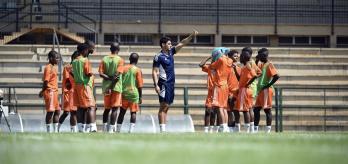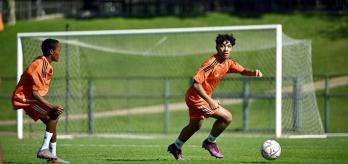Methodology
The intention: What is practised?
The objective of this possession game is to enhance a unit’s ability to retain possession and move the ball between channels effectively when under constant pressure. The exercise emphasises unit actions, including positional awareness between lines and creating and opening up passing lanes between players. The unit are tasked with helping the ball carrier to overcome the press and should provide multiple passing options across the channels and lines to avoid being boxed in. Thinking two or three steps ahead helps the unit to knit passes together in tight spaces, whilst the unit’s depth and width provide long passing options that help to bypass the press. Well-timed movement into space can help players to arrive at the moment of the pass and make them less predictable to the opposition.
The scale: For whom is this relevant?
This opposed possession game is specific to the unit scale, focusing on retaining possession when under constant pressure and operating in a reduced space. The exercise is not particularly relevant to a specific system or phase of play and can be applied to all scenarios in which a team are under pressure and try to play through the press by using the channels. For example, if a team are playing in tight spaces with pressure on one side of the pitch, a player should be available in the inner channel to provide a short option. Additionally, a second player on the opposite channel should offer a longer option, with other players supporting under the ball.
The practice type: How is the practice designed?
The drill involves an opposed possession game contested in a focused area of the pitch that is designed to help a unit play through intense pressure. The reduced size of the exercise area and the number of players involved add time and spatial constraints that require the unit to display quick decision-making, movement and passing. The requirement for one player to occupy each of the three channels at all times serves to make players aware of the importance of their positioning. The exercise is non-position-specific, although players must adapt to the position in which they find themselves. For example, if a player is located in a central area, they are likely to come under pressure from all angles, and they must therefore adopt 360° vision.
Session plan
Organisation
• Mark out a 20m x 20m exercise area and split it into thirds lengthways.
• Set up a 5v5 scenario (oranges v. blues) inside the exercise area.
• Arrange the teams so that at least 1 member of each team is in each channel.
Explanation
• The first coach plays the ball to any player.
• The in-possession team try to circulate the ball, with at least 1 player occupying each channel at all times.
• The out-of-possession team try to win the ball.
• If the out-of-possession team gain possession, the teams swap roles immediately.
• Each time the ball goes out of play, a coach plays in a new ball.
• If they complete 7 passes, the in-possession team are awarded 1 point.
Key coaching points















